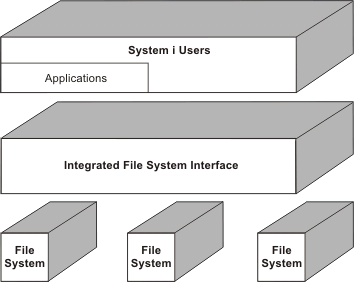Why use the integrated file system
The integrated file system enhances the already extensive data management capabilities of i5/OS® with additional capabilities to better support emerging and future forms of information processing, such as client/server, open systems, and multimedia.
You can use the integrated file system to do the following things:
- Provide fast access to i5/OS data,
especially for applications such as iSeries™ Access that use the i5/OS file server.
- Allow more efficient handling of types of stream data, such as images,
audio, and video.
- Provide a file system base and a directory base for supporting open system standards based on the UNIX® operating system, such as Portable Operating System Interface for Computer Environments (POSIX) and X/Open Portability Guide (XPG). This file structure and this directory structure also provides a familiar environment for users of PC operating systems, such as Disk Operating System (DOS) and Windows® operating systems.
- Allow file support with unique capabilities (such as record-oriented database files, UNIX operating system-based stream files, and file serving) to be handled as separate file systems, while allowing them all to be managed through a common interface. Figure 1. A common interface to separate file systems

- Allow PC users to take better advantage of their graphical user interface. For example, Windows users can use the Windows graphical tools to operate on i5/OS stream files and other objects in the same way they operate on files stored on their PCs.
- Provide continuity of object names and associated object information across national languages. For example, this ensures that individual characters remain the same when switching from the code page of one language to the code page of another language.
Parent topic:
Overview of the integrated file system
Related concepts
File systems